When consumers think of a loyalty program, they usually think of points. That’s because most retention programs are points-based, earning them the nickname “earn and burn”.
Simplicity is one reason these point-based loyalty programs are so popular. Brands want to offer their customers a simple value proposition that will keep members coming back.
But based on our research, there is a “right” way and a “wrong” way to run a points-based loyalty program. This article will share the positive attributes of these programs and what to avoid.
What is a Points-Based Loyalty Program?
A points-based loyalty program rewards consumers with points for each purchase, typically 1 point earned for every dollar spent at a specific brand. When members reach a pre-determined threshold, they can redeem those points for a product, a discount or an experience.
While the program’s value proposition is easy for consumers to understand, it also entices them to make repeat purchases with an eye on the rewards. There is little barrier to entry for customers to sign up and these programs excel at collecting valuable data.
However, these programs are quite common among brands, but when almost every brand has this type of program, that also makes it harder to differentiate yourself from your competition.
Why are These Programs Effective?
Points-based loyalty programs work for brands and your customers because they’re simple to join and easy to understand the mechanics. This is also a great way to get consumers into your loyalty ecosystem where they could enjoy the option of tiered or premium loyalty.
Consider that 83% of consumers are likely to invest in a brand’s premium loyalty program if they already belong to that brand’s traditional loyalty program.
These rewards programs allow you to collect valuable member data, which is important because it lets you cross-sell and target incentives with your best customers.
Zero-party data is data that customers intentionally and willingly share with your brand. It can include preference center data, purchase intentions, personal context and how the individual consumer wants the brand to recognize them.
This kind of data is extremely important because it’s customers intentionally raising their hands to volunteer specific information that will help you create a more personalized experience, figure out what types of rewards to offer and optimize your program over time.
What to Include in Your Points-based Loyalty Program and What to Avoid
According to recent loyalty program statistics, 81% of consumers agree that holding a loyalty program membership to a brand influences their likelihood of making a purchase from that brand.
But you must make the signup process simple and easy to understand because the No. 1 reason consumers don’t sign up for a brand’s loyalty program is because it requires too much effort/it’s time-consuming.
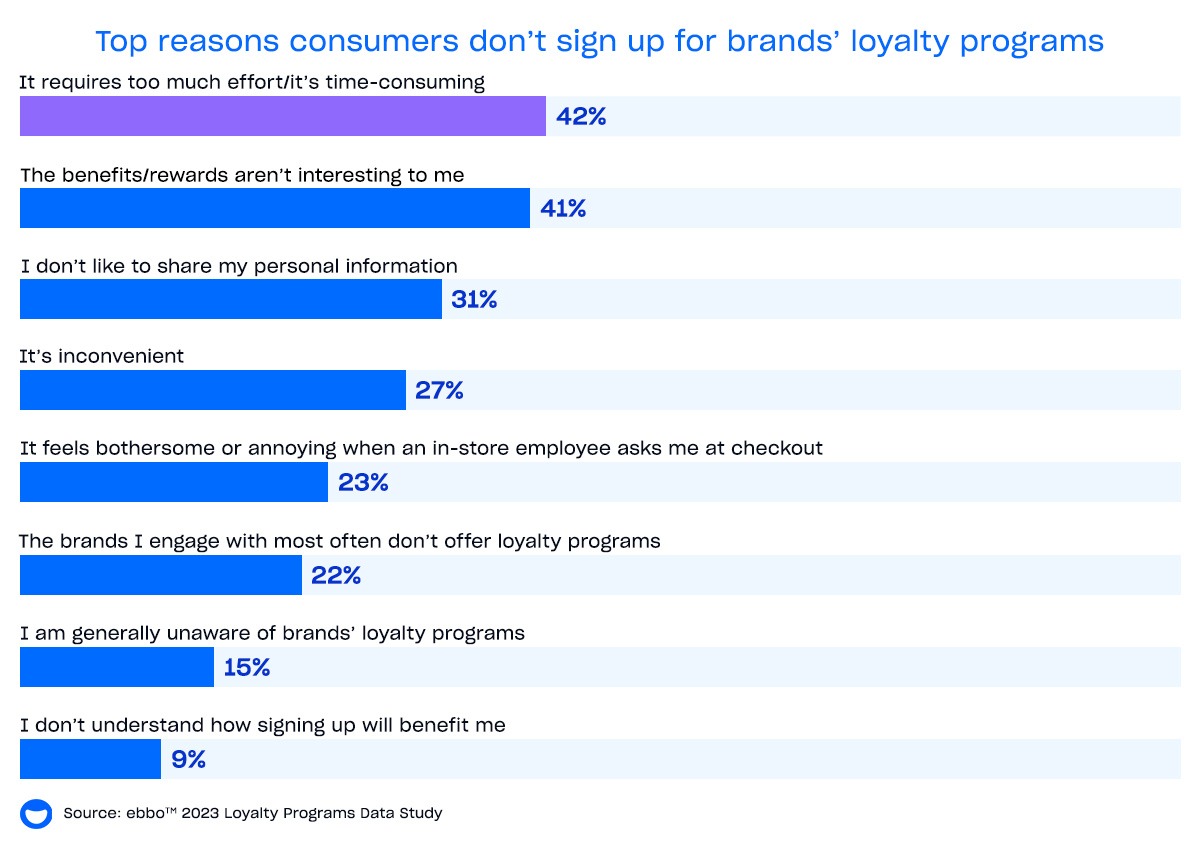
Based on our research, these are the top reasons consumers don’t sign up for brands’ loyalty programs:
- It requires too much effort/time consuming 42%
- The benefits/rewards aren’t interesting to me 41%
- I don’t like to share my personal information 31%
- It’s inconvenient 27%
- It feels bothersome or annoying when an in-store associate asks me at checkout 23%
- The brands I engage with most often don’t offer loyalty programs 22%
- I am generally unaware of brands’ loyalty programs 15%
- I don’t understand how signing up will benefit me 9%
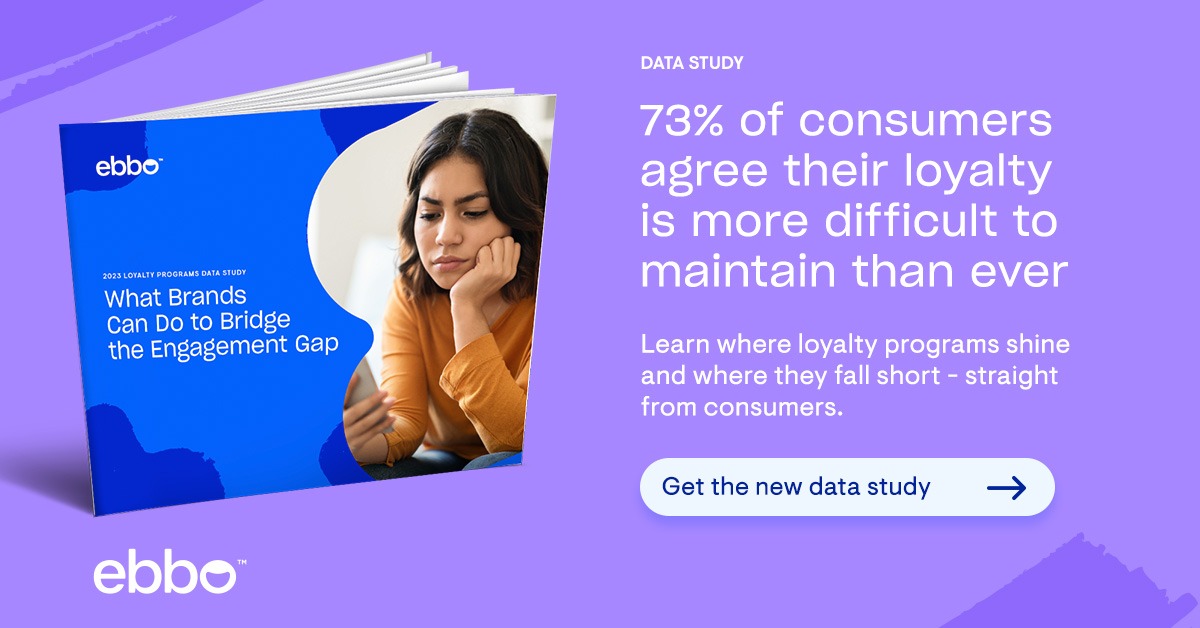
Download our 2023 Loyalty Programs Data Study.
Too many loyalty programs feel similar and don’t differentiate themselves, according to 91% of consumers.
So, what can you do to differentiate your loyalty program?
Personalize offers based on customer preferences. Ninety percent of consumers agree that when it comes to personalizing their preferences, most loyalty programs have room for improvement.
Also, offer different tiers in your loyalty program based on spend. Consider that 74% of consumers agree that they would engage more with brands that offered different tiers in their loyalty programs based on how much they spend per year.
Based on our research, these are the Top 5 most important rewards for consumers in a points-based loyalty program:
- Discounts, coupons and/or cash-back on purchases – 82%
- Free or discounted shipping – 57%
- Surprise rewards – 28%
- Members-only experiences (i.e., early access to new product drops, members-only sale events, express checkout in-store, VIP customer service, community events) – 26%
- Chances to win a prize – 20%
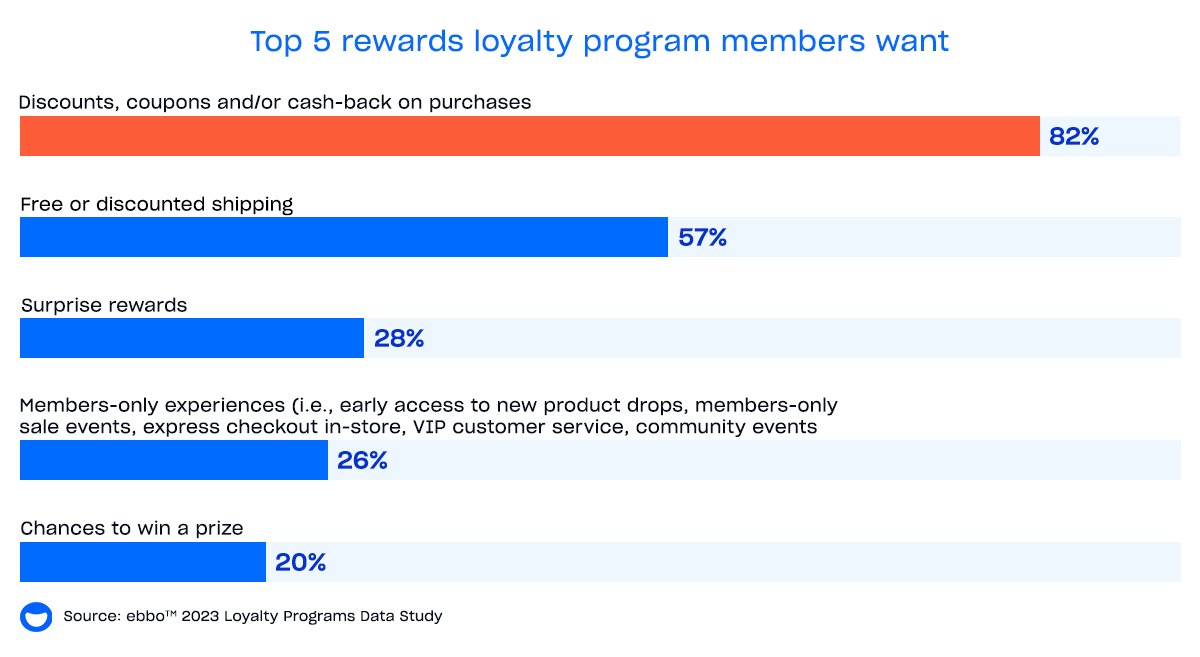
Also, here are the Top 5 things consumers would love to see from their favorite loyalty programs in the future:
- More attainable rewards (not having to save up large amounts of points for big-ticket items but the opportunity to redeem smaller amounts of points for smaller rewards) 71%
- More options for what you can redeem your points for aside from just coupons or discounts 67%
- Being rewarded more for engaging with the brand beyond just purchase (like leaving a product review online, filling out a personality profile, taking a quiz or contributing user-generated content like sharing photos or an experience with the brand on social media) 40%
- More access to exclusive members-only experiences 25%
- More of a sense of community for other brand fans (i.e., fan clubs, user groups, meetups, classes) 12%
Keep it simple and personalized and your points-based loyalty program will be a success.
Examples of Points-Based Loyalty Programs
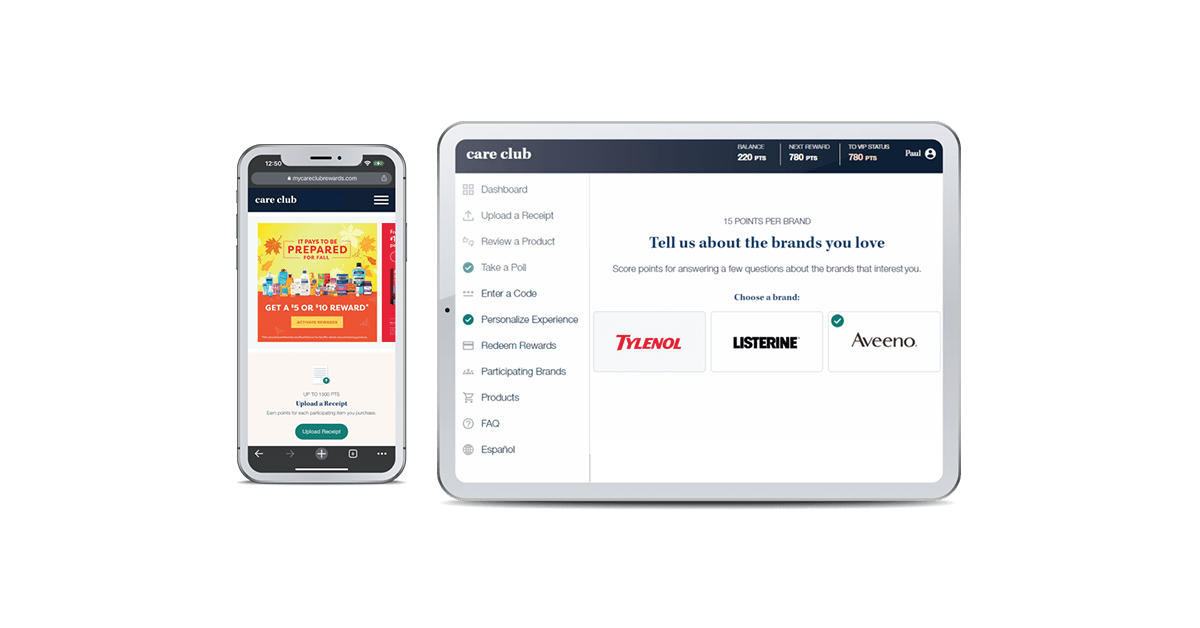
Johnson & Johnson My Care Club Rewards: Care Club is a healthy-living lifestyle loyalty program built around value-add information and insights coupled with Johnson & Johnson products. This innovative portfolio program covers 26 Johnson & Johnson brands.
Members earn points for product purchases, reviewing products, taking polls about product usage in their lives and personalization actions that help define the program experience.
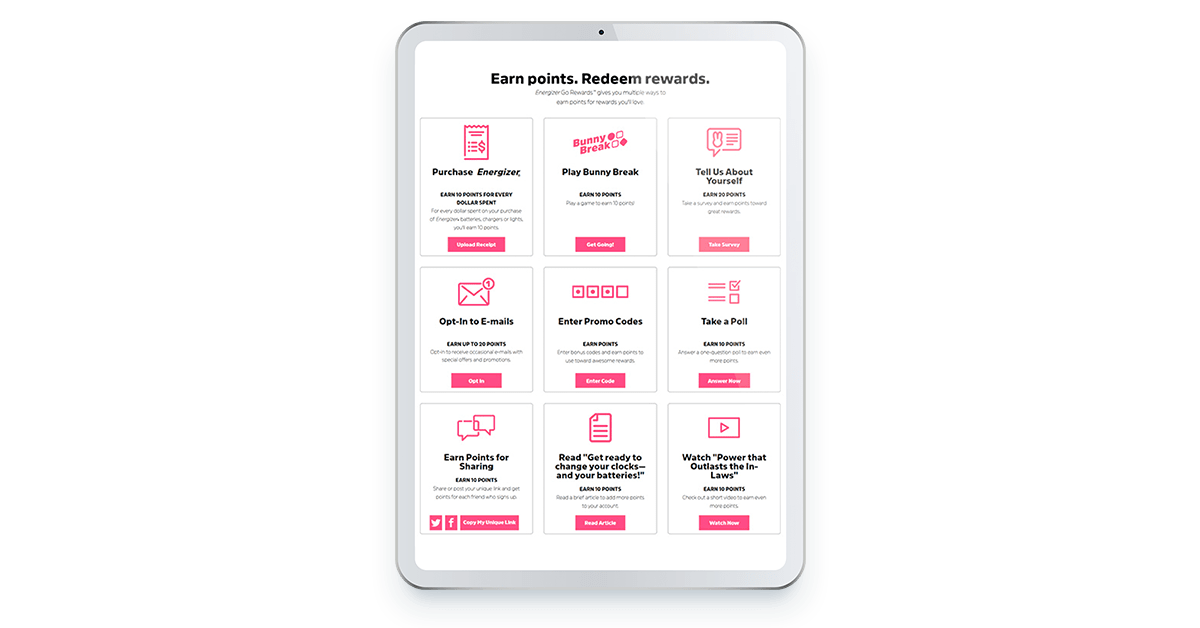
Energizer Go Rewards: This program has offered a rebate incentive.
To receive the $5 rebate, consumers had to purchase at least $15 worth of any Energizer Brand battery or lighting products in a single transaction at any retailer (excluding Lowe’s) during a specified five-month period.
Then, consumers were asked to take a photo of their original receipt and visit a link to submit it and redeem the rebate. To submit receipts, participants were required to be members of the Energizer Go Rewards loyalty program.
Members upload receipts of qualifying Energizer batteries, lights and charger purchases or complete activities like survey questionnaires, polls, refer a friend, view videos and more within the Energizer Go Rewards program.
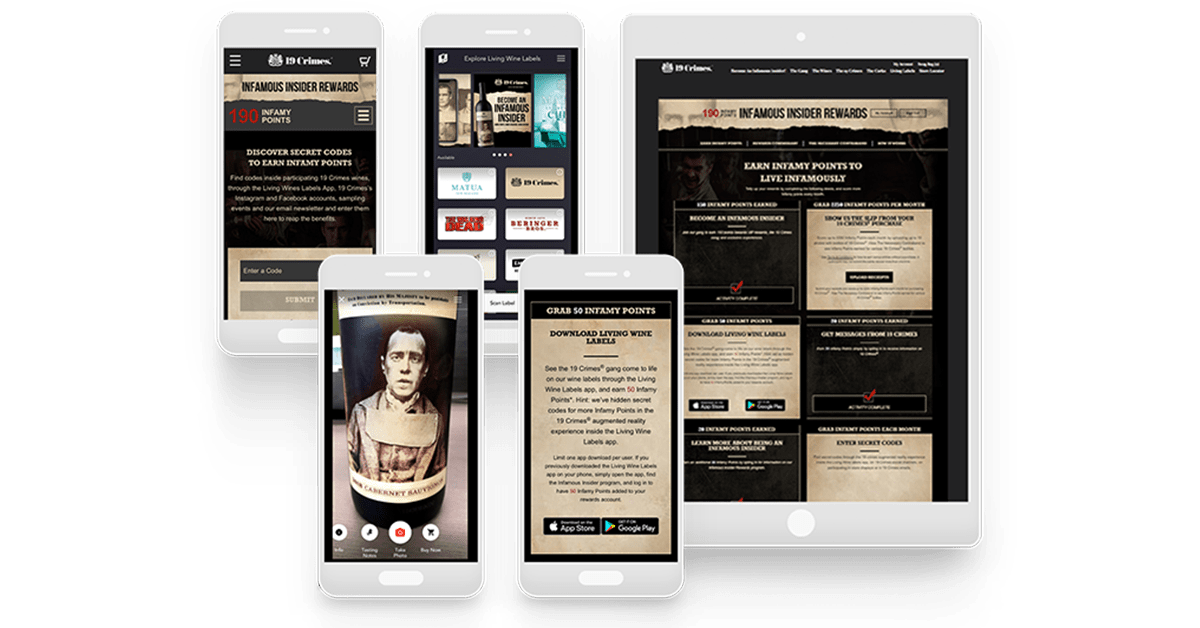
19 Crimes Infamous Insider Rewards: Members complete tasks mapped out in the dashboard to accrue points they can use to enter a sweepstakes to win prizes such as swag, VIP benefits and chances to win exclusive prizes.
The Infamous Insider Rewards loyalty program allows members to redeem smaller quantities of points for unique rewards rather than only requiring large numbers of points for bigger ticket items.
Infamous Insiders can redeem points to create custom wine labels that can then be added to a 19 Crimes bottle once printed. It’s brand- and product-centric and gives its loyalty members a very achievable reward.
And leaning into this wine label function within its Infamous Insider Platform, 19 Crimes leveraged a loyalty amplifier, the Partners in Wine sweepstakes, to help drive further member acquisition and program participation.
Think about making this an option as part of your loyalty program since there are a significant number of consumers who would rather use their loyalty points to enter a sweepstakes to win a prize or experience, instead of using them for a product or service discount.
Score Points With Your Best Customers
A points-based program plays a critical role in your overall loyalty strategy and is great for acquiring new customers. And after you receive personal data from members, you can tailor communications and experiences and build long-term relationships.
These programs are popular because they’re easy to join and understand, which leads to greater brand engagement.
If you’d like to learn more, check out our points-based loyalty page here.